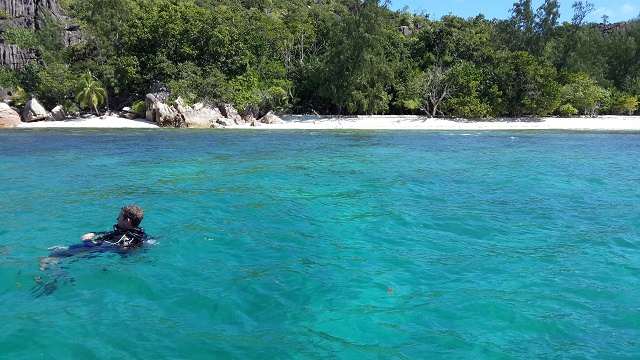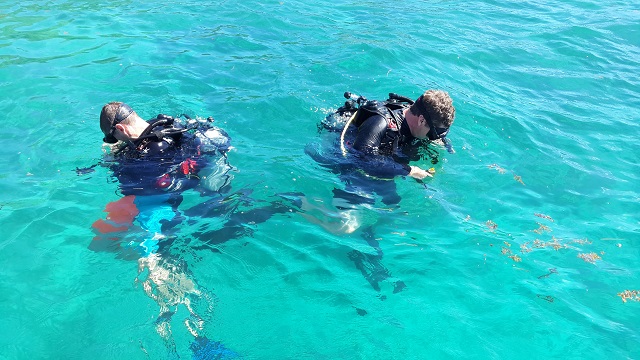How will corals survive in 200 years? Earthwatch expedition studies possibilities in Seychelles

Curieuse Island is the site of a stimulating research conducted by Earthwatch Institute in the past six years, on how coral will sustain high ocean acidity in 200 years as a result of climate change. (Seychelles News Agency)
(Seychelles News Agency) - The seawall of Curieuse island and its lagoon are the site of a stimulating scientific inquiry in the Seychelles islands, where researchers from the University of Essex coral reef research unit are heading an Earthwatch Institute expedition to investigate coral growth in conditions that are expected to occur in the world’s oceans in 200 years time, taking into account climate change and ocean acidification.
Built in 1909, the seawall created a lagoon cradled by marshes at Baie Laraie, where thousands of hawksbill turtles were bred for trading purposes. The lagoon proved unsuccessful as most of the turtles died of diseases.
Furthermore, the Indian Ocean archipelago was already endorsing the prospect of protecting these species and hence the structure became a mere attraction for visitors on the island. In 1968, a ban on harvesting green turtles was introduced and then in 1994, a total legal ban on all turtle harvesting was established in the archipelago.
Years later, the already crumbling seawall could not withstand the tsunami of 26 December 2004 which sent waves to the Indian Ocean islands from the epicentre of the Sumatra earthquake in Indonesia.
Attempts to reconstruct the wall, made of rocks and cement, have not been entirely successful.
Instead, the rhythmic movement of the tide has deepens the lagoon inside the seawall creating a healthy ecosystem for different species such as eagle rays and mullets which find food on an equally flourishing coral community.
These corals are thriving in adverse conditions and researchers are in awe, and very curious to find out why they are flourishing in these conditions.
“We have noticed that the pH of the sea inside the lagoon varies from 7.6 and 8.2 throughout the day and this is what has been predicted will happen in the world’s ocean in 200 years due to climate change” said Dr. David Smith, professor and director of the coral reef research unit, at the University of Essex, who is leading the Earthwatch Institute expedition.
|
|
| A remnant of the 1900s, the seawall of Curieuse (on the right) is one of the main attractions for visitors on the island along with other natural treasures such as the Coco de Mer and a large population of giant tortoises. The lagoon behind the seawall now serves as a living laboratory for researchers of the Earthwatch expedition as they investigate coral growth.(Seychelles News Agency) Photo License: CC-BY |
According to Smith, until further tests are done, the research unit is unsure if the corals from the lagoon of Curieuse have a different genetic makeup or if they have naturally adapted to this extreme environment.
Falling pH levels show greater acidity in the ocean floors due to an increase in carbon dioxide in the atmosphere and scientists are predicting more damage, or worse, a high mortality in corals across the globe.
 |
| The Earthwatch Institute shares knowledge on coral reefs and the marine environment through various methods of teaching including theoretical and practical demonstrations. (Seychelles News Agency) Photo License: CC-BY |
The expedition in Seychelles has found other surprising discoveries in the protected marine park around Curieuse, a small granitic island located fifteen minutes by boat from Praslin Island, the second most populated island of the archipelago.
“Most places, over 20 different countries where we have coral research programmes, the health of coral reefs is going down but Curieuse is one of those unique places where the health system is actually going up because it is so well protected,” Smith told SNA.
The Earthwatch Institute, an international non-profit organisation, has been actively involved in research and conservation in the Seychelles since 2006, mainly in monitoring corals, conducting marine surveys, discussing the importance of the reefs with local communities and to collect data on the perceived changes on reefs. The main source of food for the islanders, the fish of the ocean, are dependent on the health of the reefs.
“We have throughout the years worked with the Seychelles National Park Authority, SNPA, in identifying areas within the protected areas that are important in terms of coral growth. These areas are special banks of genetic diversity and have a diverse number of coral species which can be used to reseed [transplanted] in other affected areas outside of the marine park,” says Smith, adding that the programme is a flagship in international collaboration towards the environment.
 |
| Earthwatch volunteers will spend one month assessing the coral reefs, collecting data on fish species and density as well as surveying any potential threat to the marine environment of the island. (Seychelles News Agency) Photo License: CC-BY |
Discovering the marine life of Seychelles
The expedition usually lasts over four weeks, with over ten volunteers hailing from different countries around the world, all the way from United States to Germany.These include fellows sponsored by Mitsubishi Corporation, one of the world’s largest car manufacturers, from Japan.
"As individuals, we each think we can’t make a difference but we can. For us in different countries and different continents, we can go back to our colleagues, our friends and share the stuff we have learned, solutions and other factors that are affecting the coral,” said Lynn Waller, a fellow from the motor vehicle division of Mitsubishi Corporation, in South Africa.
Another Mitsubishi beneficiary, Katia Wever, from Germany, was also in awe of her surroundings on Curieuse.
“It’s a completely different life for me. Yesterday, was the first time I was snorkelling and I could not get enough of this…We are learning so much about all the fish and corals, and I am enjoying my time here.”
 |
| Volunteering for a scientific research project can also be a fun experience, for some the first time to dive, snorkel and live on a tropical island (Seychelles News Agency) Photo License: CC-BY |
When they are not snorkelling or diving, the volunteers are involved in aquarium experiments and data analysis.
“What our research is demonstrating is that we don’t think coral reefs will disappear,” said William Forsee, a retired biology teacher from a high school in Nebraska in the United States.
“I taught students on the foreseeable future of living without corals but after coming here, I believe we can find solutions to these problems. And the solutions are in the oceans around us.”
| Watch: the abundance of fishes and corals of Curieuse is depicted in this video as volunteers go about with their monitoring a few meters from the beach of Grand Anse on Curieuse island, Seychelles. (Professor David Smith / Earthwatch Seychelles) Video License: All Rights Reserved |
Earthwatch is the second group of international volunteers based on Curieuse island, as Global Vision International has a permanent base on the island.
Being the second island, after Praslin where the Coco de Mer, the largest nut in the world grows in its natural state, Curieuse was declared a protected island in 1979.
The island is also renowned for its large population of Aldabra giant tortoises, relocated in the late 1970 from the Aldabra atoll, a UNESCO World Heritage site.






